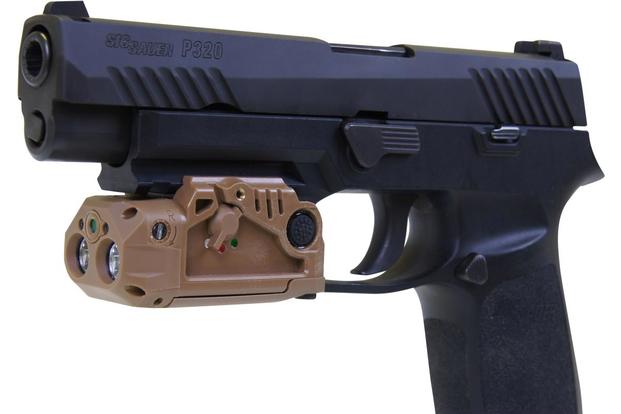U.S. Army equipment officials are working on a program to find a new pistol holster that will allow soldiers to carry the Modular Handgun System with or without a weapon light and aiming laser mounted to it.
Last year, the Army selected a holster, made by The Safariland Group, to issue initially with its new XM17 MHS but planned to find a light-compatible holster for units that need the capability.
The MHS, made by Sig Sauer, features an accessory rail that allows soldiers to mount pistol lights and other devices for operating in low-light conditions.
"I have the rail on the pistol; now I need to get you the enabler to go with it," said Daryl Easlick, small arms deputy for the Lethality Branch at Fort Benning, Georgia. "And you are going to have to be able to holster it."
The Army has identified pistol lights with infrared aiming lasers made by LaserMax Defense and Streamlight that meet its requirements, and the service is close to selecting a holster that will work with both devices, Easlick said.
Equipment officials from Program Executive Office Soldier have "been working for the last year trying to get source selection complete on the Modular Handgun Holster program of record," he said. "That source selection should be near completion ... from what they have told us, it's any day now."
Military.com reached out to PEO Soldier to ask about the new holster selection, but did not receive a response by press time.
The Army plans to issue the full-size XM17 version of MHS to team leaders and above in infantry and other combat-arms units as well as military police in what's being called a dual-armed strategy.
Soldiers will train to transition from their M4 carbines to the MHS in situations where they have a weapons malfunction and targets are too close to fix the stoppage, Easlick said.
"Rather than fixing a stoppage ... I'm going to transition to a different weapon system, engage those targets and then get my carbine back in the fight," he said. "If they are doing that in the daytime, they should be doing that at night as well."
Last year, the Army began an effort under the Soldier Enhancement Program to find a weapon light and holster that would work together.
The challenge is that most light-compatible, polymer holsters grip the weapon light, not the pistol, so the weapon must have the device attached to fit securely in the holster.
"We wanted the holster to be able to take the weapon, whether it has a light on it or not," Easlick said. "We did a lot of discussions with the companies that are out there -- how do you get a weapon to slide into the holster and lock when you don't have all of the parts on there? That is where we started, because that was a key requirement taking the gun, lit or unlit."
Army officials decided that the weapon light would have to be no more than 1.5 inches wide and not extend beyond the frame of the XM17.
"That's what has to fit in the holster," Easlick said, explaining the dimensions holster manufacturers were given.
The device would have to have enough power to allow the soldier to see if there is a weapon in the potential target's hands at 25 meters, and have a continuous runtime of 90 minutes, he said.
So far, LaserMax Defense and Streamlight have "come and said they have something that will fit," Easlick said.
Sometime this summer, the Army will have soldiers from operational units evaluate both light models, he said. The four-day event will have soldiers shooting the MHS with each device attached in operational scenarios to get feedback on soldier acceptance.
For now, the program will remain in the Soldier Enhancement Program, so the "intent would be, if you meet the requirements for all of it ... we would assign an NSN," Easlick said, describing how unit commanders could then use the national stock numbers to purchase them with unit funds.
"We tried to make sure we were clear and upfront with the vendors ... especially if this is going to be a unit commander thing, I don't want them spending their entire annual allocation of unit funds on pistol lights," he said.
Army officials are trying to find funding to make this a program of record, Easlick said.
But "we have got a lot of stuff going on and this isn't the highest priority," he added.
"We want to get a program of record for this, but we are also realistic; I would rather have a [weapon light] on my rifle than I would on my pistol," he said.
-- Matthew Cox can be reached matthew.cox@military.com.










